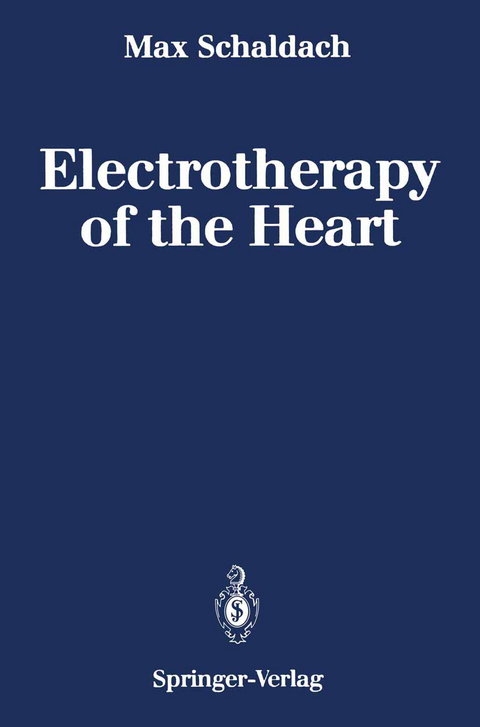
Electrotherapy of the Heart
Springer Berlin (Verlag)
978-3-642-50211-8 (ISBN)
Most up-to-date review of the important technological advances and concepts in cardiac electrotherapy.
Basic Anatomy and Physiology of the Heart.- Position and Structure of the Heart.- Generation and Tine Course of Excitation.- Excitation-Contraction Coupling and the Contraction Process.- Physiology of the Heartbeat.- The Pacemaker Potential and the Spread of Excitation.- Cardiac Mechanics.- Adjustments of the Heartbeat.- Neural-Humoral Control of Circulation.- Role of the Autonomic Nervous System in Cardiovascular Regulation.- Circulatory Regulation in Patients with Disorders of the Heart's Pacemaking or Conducting System.- Monitoring the Electrical Activity of the Heart.- Pathophysiology.- Disorders of the Pacemaking Function.- Disturbances of Conduction.- Therapy for Cardiac Rhythm Disturbances.- Electrotherapy in the Treatment of Cardiac Rhythm Disturbances.- Pacemaker Technology.- Implantable Pacemakers: History, Current Status and Trends.- Multiprogrammable Single-Chamber Pacemakers.- Technical Solution for the Multiprogrammable Single-Chamber Pacemaker.- Multiprogrammable Dual-Chamber Pacemaker.- Technical Solution for the Dual-Chamber Pacemaker.- Controlled and Regulated Pacemakers.- Control Aspects of Cardiac Output Adjustment.- Different Strategies of Rate Adaptation.- Forward Consideration of Disturbance Variables.- Open-Loop Control Using Corporeal, Non-Cardiac State Variables.- Rate Adaptation Using Cardiac Parameters.- Status of the Application of Corporeal Control Parameters.- Motion Energy as a Control Parameter.- Central Venous Temperature as a Corporeal Control Parameter.- Cardiac Control Parameters.- Principles of Intracardiac Conductance Measurement.- Basic Aspects of Conductance.- Anisotropic Impedance.- Employment of PEP for Rate Adaptation.- Improving the PEP Control: Concept of VIP.- Unipolar Right Ventricular Conductance Measurement.- ClinicalResults.- Employment of Volume Information for Rate Adaptation.- Conclusions.- The Stimulating Electrode.- Electrode/Myocardium Interface.- Helmholtz Doublelayer.- Electrical Characteristics.- Electrode Materials.- Porous Electrode.- TiN as an Electrode Material.- Comparative Studies.- Materials in Pacemaker Technology.- Definition of a Biomaterial.- Summary of Biomaterials in Common Use.- General Characteristics of Biomaterials.- Biomaterials in Soft-Tissue Implants.- Resistance to Corrosion.- Biocompatibility.- Quality Testing and Reliability.- Physiological Characteristics of the Blood.- Interactions Between Blood and Artificial Surfaces.- Determination of Blood Compatibility.- Pacemaker Power Sources.- Battery Development.- State of the Art in Pacemaker Power Sources.- The Elements of a Primary Battery.- Battery Performance.- Chemistry of the Lithium/Iodine-Polyvinylpyridine (Li/I2-PVP) System.- Design of Lithium/Iodine-PVP Cells.- Discharge Characteristics of the Li/I2-PVP Battery.- Cell Design and Qualification.- Reestablishment of Physiological Regulation-A Challenge to Technology.- New Concepts in Electrotherapy of the Heart.- Conclusions.
| Erscheint lt. Verlag | 2.6.2012 |
|---|---|
| Zusatzinfo | XIV, 253 p. 123 illus. |
| Verlagsort | Berlin |
| Sprache | englisch |
| Maße | 155 x 235 mm |
| Gewicht | 410 g |
| Themenwelt | Medizinische Fachgebiete ► Innere Medizin ► Kardiologie / Angiologie |
| Medizin / Pharmazie ► Physiotherapie / Ergotherapie ► Orthopädie | |
| Naturwissenschaften ► Physik / Astronomie ► Angewandte Physik | |
| Technik | |
| Schlagworte | anatomy • Biomaterial • Cardiac Control • Cardiovascular • cardiovascular regulation • Circulation • heart • Herzschrittmacher • Mechanics • Medicine • Monitor • nervous system • pacemaker • pathophysiology • Physiology • Temperature • tissue |
| ISBN-10 | 3-642-50211-3 / 3642502113 |
| ISBN-13 | 978-3-642-50211-8 / 9783642502118 |
| Zustand | Neuware |
| Haben Sie eine Frage zum Produkt? |
aus dem Bereich


